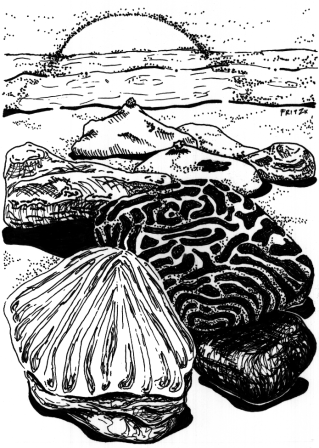The geologist is a former colleague of mine. Her work entitled "A lower limit for atmospheric carbon dioxide levels 3.2 billion years ago" was published in the flagship scientific journal Nature (March, 2004, Vol. 45, Pg. 736).
The other day I was talking to a geologist friend of mine who told me about a pebble she found that held a clue to the amount of carbon dioxide in Earth's atmosphere 3.2 billion years ago. The walnut-sized pebble, she explained, was found in a slender core sample drilled from a gold mine in South Africa, its timeworn surface long ago weathered to a rind by running water.
My geologist friend discovered that the pebble's crusty skin is made of quartz (like beach sand) and iron-rich carbonate minerals.
The iron-rich carbonate is the clue. Carbonate contains a lot of carbon.

{Pebbles. Copyright 2024 by William Fritz.}
Pebbles like the one my geologist friend found, that are weathered in equilibrium with Earth's present-day oxygen-rich atmosphere, end up crusty with iron-rich silicate minerals (like brown-red beach sand) and iron-oxide minerals (just plain rust). The iron-rich carbonate minerals coating the geologist's pebble could only have resulted from weathering in an atmosphere with very little oxygen.
I wondered why this was important until I ran into an astronomer colleague of mine who told me about a star he observed that held a clue to the temperature of the sun 3.2 billion years ago. The sun-like star, he explained, appears young and cool at the end of the slender line of sight of his telescope, its shimmering surface emitting just 70% of the energy that the sun does today.
My astronomer colleague discovered that stars like this one--and thus like the sun--blaze brighter as they age to maturity. The sun was considerably less of a source of light and heat 3.2 billion years ago than it is today. But was the earth back then cooler than it is now?
I found a physicist who was enthusiastic to work out an answer to this question, under the assumption that the Earth and its atmosphere were back then the same as they are today.
Earth's average global temperature, the physicist explained, is set by the balance between the energy absorbed from the sun and the energy radiated back into the blackness of space.
When the sun was 30% less intense, the balance would have shifted Earth's average global temperature from comfortably above the freezing point of water to a few degrees below.
But what about the geologic evidence that earth has long been awash in liquid water? What about the evolution of life in warm, quiet ponds? Was the earth ever really as cool as the physicist calculated? The geologist's pebble helps answer these questions.
It is well known that when Earth is blanketed by carbon dioxide and other so-called greenhouse gasses, it radiates less energy back into space and becomes warmer. Greenhouse gasses increase the average global temperature that balances absorbed and re-radiated energy.
Earth was as warm 3.2 billion years ago as it is today, in spite of the then young, cool sun, because the amount of carbon dioxide in Earth's atmosphere was much higher than it is today.
This message was brought to you from the distant past by the geologist's tiny pebble.